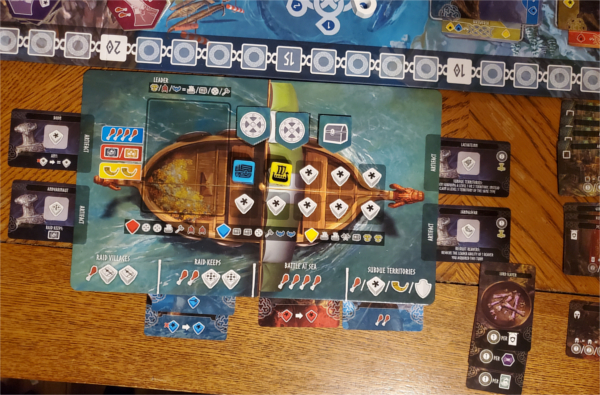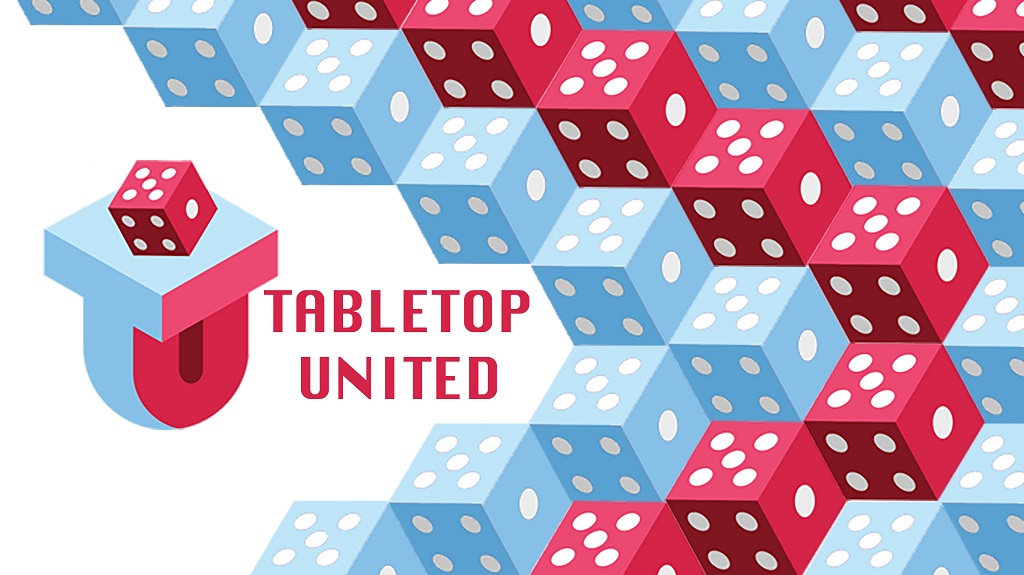
Reavers of Midgard
Designer: J.B. Howell
Artist: Yaroslav Radetskyi
Publisher: Grey Fox Games
Year Published: 2019
No. of Players: 2-4
Ages: 14+
Playing Time: 60-120 min
Main mechanic / Theme: Worker Placement, Card/Dice Drafting, Set Collection, Following
Find more info on BoardGameGeek.com
Overview:

Reavers is a worker placement game where each player will choose one action on their turn, pay the cost, and gain the benefits and bonuses. Each other player will either follow (by taking the same action in much the same way, but with fewer rewards) or rest (to gain any die on the face of their preference or two food). You'll be able to do up to four actions each turn, but you must choose which to give priority. Being the initiator can provide up to three times the benefit and the first pick from the available assets.
There are many ways to gain points both during and after the game. You're likely to end up with hundreds. There's too much endgame to keep track of who is winning, so it's best to focus on doing your best rather than tripping others up. Aside from getting better bonuses and a couple of cards that allow you to give another player a Terror token (worth negative points at the end), there's not a lot of aggression between players.
Actions in detail (or you can watch my 8-minute rule reminder video HERE)
Subdue Territories- Territories provide an immediate bonus printed on them, plus 1VP at the end of each round. These can gain you a lot of points during the game. You can do this two ways.
- Discard hammer dice and roll successes equal to or greater than the number in the shield.
- Discard the resources pictured.
The player aid tells you what immediate bonuses you may get for each of the stacks.
Raid Keeps- You'll choose a set of linked cards to add to your collection. Treasure, Art, Tapestries, and Armor give you exponential points for collecting sets of that type at the end of the game. Some of the cards give you dice or favor tokens plus a chance to battle for tokens that provide endgame points depending on how many you have. Each token type has a base value, but the more you have, the more each is worth. There is an additional point bonus for the player with the most of each token type. The downside is that you have to spend hammer dice to do the battle part, so those can feel like a waste.
Raid Villages- You'll get all kinds of stuff from villages.
Artifacts give you extra dice storage on your ship plus a unique action.
Ship upgrades- Each ship can take up to three upgrades. You can flip an upgrade token once per round to pay a symbol. They are like permanent workers that don't take up space. You can choose to take the points depicted on the card instead. The only reason to pass on one of these is if you already have three, or if you're saving space for a specific upgrade.
Weapons/Farms/Village Walls- These give you resources and an option to take more resources and Terror tokens. (Terror=Bad)
Runic Carvings- These are one of the few ways to get rid of terror and force other players to take it.
Battle at Sea- This is the most complex action. Sailing can entail unforeseen peril, so draw a Journey card to see if you encounter trouble. Lose any assets printed on the card. Now you can choose one of the face-up battles, or draw a new one. A successful sea battle provides a lot of points, but requires you to either roll a certain number of successes (number in shield) or spend a bunch of dice with specific faces. These can also provide a bonus printed in the bottom left. You gain battle dice by spending hammer dice from your ship. Roll battle dice equal to the number of discarded hammers. Each ax pictured is a hit. If you meet or exceed the target, gain the points plus bonuses printed on the card. Add the battle card to your discard pile.
Trade With Villages- Gain either dice, favor, food, or prophesy cards. Prophesy cards give you endgame points for various stuff in your discard pile.
Recruit Reavers- Take a stack of two Reavers or draw two from the deck. Gain their dice then appoint them using the three options described in setup.
For each action, you will pay any depicted cost, gain bonuses from specialists on your layer board, gain bonuses on the board (depending on player order), and do the action. You get a lot of resources. I rarely didn't have what I needed to do an action. The tension feels like a less-mathy Five Tribes. You have a lot of incentive to get "there" first, but there are plenty of good options left if you don't.
I like the way they did the player-count variations. In a two-player game, you each get two ships. With three, there is an extra floating ship that will pass each turn. So, regardless of player count, everybody can do four actions each turn.Theme, Artwork, and Components:
:strip_icc()/pic4025645.jpg)
The theme is fairly well done. You get different stuff depending on where you raid, and each type of action requires different resources. Some actions are free, but most require some mixture of dice and food. I say "fairly well" because it's a bit abstract. When you recruit new Reavers, you gain the dice printed in their upper left corner. Roll to determine their talents (i.e., what quests the dice can be used on). The cards are then used one of three ways.
- You can put them in the leader slot on your player board to get the bonus associated with their color (food, cards, or glory). This also allows you to use dice with the clan symbol as wild assets.
- Slide them into one of the four specialist slots under your player board to gain their bonus when performing the associated action.
- Discard them to your glory pile to gain the dice in their upper right corner.
What I liked:
What I didn't:
Final Thoughts:
For Players Who Like:
Vikings. Eurogames. Follow the leader. Five Tribes. Point salad. Huge scores. Set collection. Engine building. If you are really into Vikings, check out my reviews of Valhalla and Raiders of the North Sea.
About the Author:
Stephen Gulik is a trans-dimensional cockroach, doomsday prophet, author, and editor at sausage-press.com. When he’s not manipulating energy fields to alter the space-time continuum, he’s playing or designing board games. He has four cats and drinks too much coffee.



